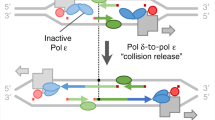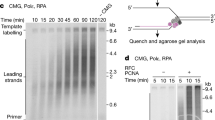Abstract
The Escherichia coli replisome contains three polymerases, one more than necessary to duplicate the two parental strands. Using single-molecule studies, we reveal two advantages conferred by the third polymerase. First, dipolymerase replisomes are inefficient at synthesizing lagging strands, leaving single-strand gaps, whereas tripolymerase replisomes fill strands almost to completion. Second, tripolymerase replisomes are much more processive than dipolymerase replisomes. These features account for the unexpected three-polymerase-structure of bacterial replisomes.
This is a preview of subscription content, access via your institution
Access options
Subscribe to this journal
Receive 12 print issues and online access
$189.00 per year
only $15.75 per issue
Buy this article
- Purchase on Springer Link
- Instant access to full article PDF
Prices may be subject to local taxes which are calculated during checkout



Similar content being viewed by others
References
Kornberg, A. & Baker, T.A. DNA replication, xiv, 931 p. (W.H. Freeman, New York, 1992).
Sinha, N.K., Morris, C.F. & Alberts, B.M. J. Biol. Chem. 255, 4290–4293 (1980).
McInerney, P., Johnson, A., Katz, F. & O'Donnell, M. Mol. Cell 27, 527–538 (2007).
Reyes-Lamothe, R., Sherratt, D.J. & Leake, M.C. Science 328, 498–501 (2010).
Johnson, A. & O'Donnell, M. Annu. Rev. Biochem. 74, 283–315 (2005).
Blinkova, A. et al. J. Bacteriol. 175, 6018–6027 (1993).
Yao, N.Y., Georgescu, R.E., Finkelstein, J. & O'Donnell, M.E. Proc. Natl. Acad. Sci. USA 106, 13236–13241 (2009).
Granéli, A., Yeykal, C.C., Robertson, R.B. & Greene, E.C. Proc. Natl. Acad. Sci. USA 103, 1221–1226 (2006).
Zechner, E.L., Wu, C.A. & Marians, K.J. J. Biol. Chem. 267, 4045–4053 (1992).
Kim, S., Dallmann, H.G., McHenry, C.S. & Marians, K.J. Cell 84, 643–650 (1996).
Tanner, N.A. et al. EMBO J. 30, 1830–1840 (2011).
Li, X. & Marians, K.J. J. Biol. Chem. 275, 34757–34765 (2000).
Yang, J., Nelson, S.W. & Benkovic, S.J. Mol. Cell 21, 153–164 (2006).
McInerney, P. & O'Donnell, M. J. Biol. Chem. 282, 25903–25916 (2007).
Hamdan, S.M., Loparo, J.J., Takahashi, M., Richardson, C.C. & van Oijen, A.M. Nature 457, 336–339 (2009).
Nossal, N.G., Makhov, A.M., Chastain, P.D. II, Jones, C.E. & Griffith, J.D. J. Biol. Chem. 282, 1098–1108 (2007).
Bonner, C.A., Hays, S., McEntee, K. & Goodman, M.F. Proc. Natl. Acad. Sci. USA 87, 7663–7667 (1990).
Courcelle, J., Khodursky, A., Peter, B., Brown, P.O. & Hanawalt, P.C. Genetics 158, 41–64 (2001).
Acknowledgements
This work was supported by US National Institutes of Health grant GM38839 to M.O.D. We thank A. van Oijen and D. Fenyo for helpful suggestions. We also thank L. Langston for suggestions and for critical reading of the manuscript.
Author information
Authors and Affiliations
Contributions
R.E.G. and I.K. carried out experiments; R.E.G., I.K. and M.E.O. designed the experiments. R.E.G., I.K. and M.E.O. wrote the manuscript.
Corresponding author
Ethics declarations
Competing interests
The authors declare no competing financial interests.
Supplementary information
Supplementary Text and Figures
Supplementary Figures 1–4 and Supplementary Methods (PDF 314 kb)
Supplementary Video 1
Replication performed by Dipol replisomes. An example of a movie depicting real-time observation of coupled leading/lagging strand replication of a mini-rolling circle substrate by E. coli Dipol replisomes. The force of the hydrodynamic flow pushes the DNA-lipid complex to a diffusion barrier etched in the glass surface and concentrates numerous DNA molecules in the visual field shown here. The width of the visible area in the direction of the flow is 73 μm (equivalent to 220 kb) and the flow direction is from top to the bottom. Individual DNA molecules visualized with the fluorescent dye Yo-Pro1 are stretched by the buffer flow (100 μl/min) and imaged through Total Internal Reflection Fluorescence (TIRF) microscopy. Toward the end of the movie, the buffer-flow is stopped, letting the strands recoil, then the buffer flow is started again. Movie contains circa 7' 30″ of experimental data rendered at 20 frames per second (original data acquisition is 1 frame/s at 100 ms exposure per frame). (MOV 1058 kb)
Supplementary Video 2
Replication performed by Tripol replisomes. The video depicts the recording of a replication reaction performed by Tripol replisomes. The movie contains circa 5' 30″ of experimental data rendered at 20 frames per second (original data acquisition is 1 frame/s at 100 ms exposure for each frame). (MOV 322 kb)
Supplementary Video 3
DNA molecules that harbor duplex regions contain gaps on the same molecule. The video depicts a recording at the end of a replication reaction using a DiPol replisome. The flow of the buffer solution is stopped then restarted, allowing the DNA strands to stretch and then recoil to their point of origin. (MOV 437 kb)
Supplementary Video 4
Use of fluorescent SSB to identify ssDNA in DNA products. The video depicts three successive recordings of different DNA products of DiPol replisomes, in which reactions contained fluorescently labeled SSB. The three successive recordings are easy to identify since they have different dimensions. The videos show that DNA products contain fluorescently labeled E. coli SSB (with Oregon Green488 Maleimide). The duplex DNA is not visualized because Yo-Pro1 is omitted from the buffer flow for these experiments. To distinguish SSB bound to DNA from SSB that binds non-specifically to the surface of the flow cell, the buffer-flow is alternatively stopped and restarted in order to observe the recoiling of the DNA strands. Fluorescent SSB bound to DNA recoils and re-extends in synchrony with the changes in buffer flow (while non-specifically bound SSB does not change position). (MOV 1871 kb)
Rights and permissions
About this article
Cite this article
Georgescu, R., Kurth, I. & O'Donnell, M. Single-molecule studies reveal the function of a third polymerase in the replisome. Nat Struct Mol Biol 19, 113–116 (2012). https://doi.org/10.1038/nsmb.2179
Received:
Accepted:
Published:
Issue Date:
DOI: https://doi.org/10.1038/nsmb.2179
This article is cited by
-
The β2 clamp in the Mycobacterium tuberculosis DNA polymerase III αβ2ε replicase promotes polymerization and reduces exonuclease activity
Scientific Reports (2016)
-
A Ctf4 trimer couples the CMG helicase to DNA polymerase α in the eukaryotic replisome
Nature (2014)
-
Mechanism of asymmetric polymerase assembly at the eukaryotic replication fork
Nature Structural & Molecular Biology (2014)
-
Bacterial replication, transcription and translation: mechanistic insights from single-molecule biochemical studies
Nature Reviews Microbiology (2013)
-
Architecture of the Pol III–clamp–exonuclease complex reveals key roles of the exonuclease subunit in processive DNA synthesis and repair
The EMBO Journal (2013)



